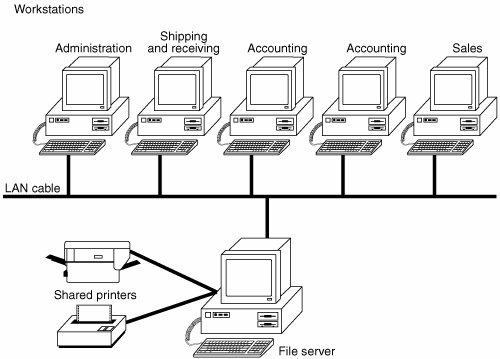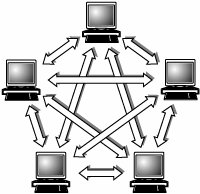ClientServer Versus Peer Networks
Client/Server Versus Peer NetworksAlthough every computer on a LAN is connected to every other computer, they do not necessarily all communicate with each other. There are two basic types of LANs, based on the communication patterns between the machinesclient/server networks and peer-to-peer networks. Client/Server NetworksOn a client/server network, every computer has a distinct role, that of either a client or a server. A server is designed to share its resources among the client computers on the network. Typically, servers are located in secured areas, such as locked closets or data centers (server rooms), because they hold an organization's most valuable data and do not have to be accessed by operators on a continuous basis. The rest of the computers on the network function as clients (see Figure 18.1). Figure 18.1. The components of a client/server LAN. A dedicated server computer typically has faster processors, more memory, and more storage space than a client because it might have to service dozens or even hundreds of users at the same time. High-performance servers typically use from two to eight processors (and that's not counting dual-core CPUs), have several gigabytes of memory installed, use the 64-bit version of the PCI expansion slot for server-optimized network interface cards, and have redundant power supplies. The server runs a special network operating systemsuch as Windows Server, Linux, Unix, or Novell NetWarethat is designed solely to facilitate the sharing of its resources. These resources can reside on a single server or on a group of servers. When more than one server is used, each server can "specialize" in a particular task (file server, print server, fax server, email server, and so on) or provide redundancy (duplicate servers) in case of server failure. For very demanding computing tasks, several servers can act as a single unit through the use of parallel processing. A client computer typically communicates only with servers, not with other clients. A client system is a standard PC that is running an operating system such as Windows XP. These versions of Windows contain the client software that enables the client computers to access the resources that servers share. Older operating systems, such as Windows 3.x and DOS, require add-on network client software to join a network. Peer-to-Peer NetworkBy contrast, on a peer-to-peer network, every computer is equal and can communicate with any other computer on the network to which it has been granted access rights (see Figure 18.2). Essentially, every computer on a peer-to-peer network can function as both a server and a client; any computer on a peer-to-peer network is considered a server if it shares a printer, a folder, a drive, or some other resource with the rest of the network. This is why you might hear about client and server activities, even when the discussion is about a peer-to-peer network. Peer-to-peer networks can be as small as two computers or as large as hundreds of systems. Although there is no theoretical limit to the size of a peer-to-peer network, performance drops significantly and security becomes a major headache on peer-based networks with more than 10 computers. Also, Microsoft imposes a 10-station limit on computers running Windows 2000 Professional or Windows XP Professional that are sharing resources with other systems. For these reasons, I recommend that you switch to a client/server network when your network climbs above 10 stations. Figure 18.2. The logical architecture of a typical peer-to-peer network. Peer-to-peer networks are more common in small offices or within a single department of a larger organization. The advantage of a peer-to-peer network is that you don't have to dedicate a computer to function as a file server. Instead, every computer can share its resources with any other. The potential disadvantages to a peer-to-peer network are that typically less security and less control exist because users normally administer their own systems, whereas client/server networks have the advantage of centralized administration. Comparing Client/Server and Peer-to-Peer NetworksClient/server LANs offer enhanced security for shared resources, greater performance, increased backup efficiency for network-based data, and the potential for the use of redundant power supplies and RAID drive arrays. Client/server LANs also have a much greater cost to purchase and maintain. Table 18.1 compares client/server and peer-to-peer server networking.
|
EAN: 2147483647
Pages: 283

